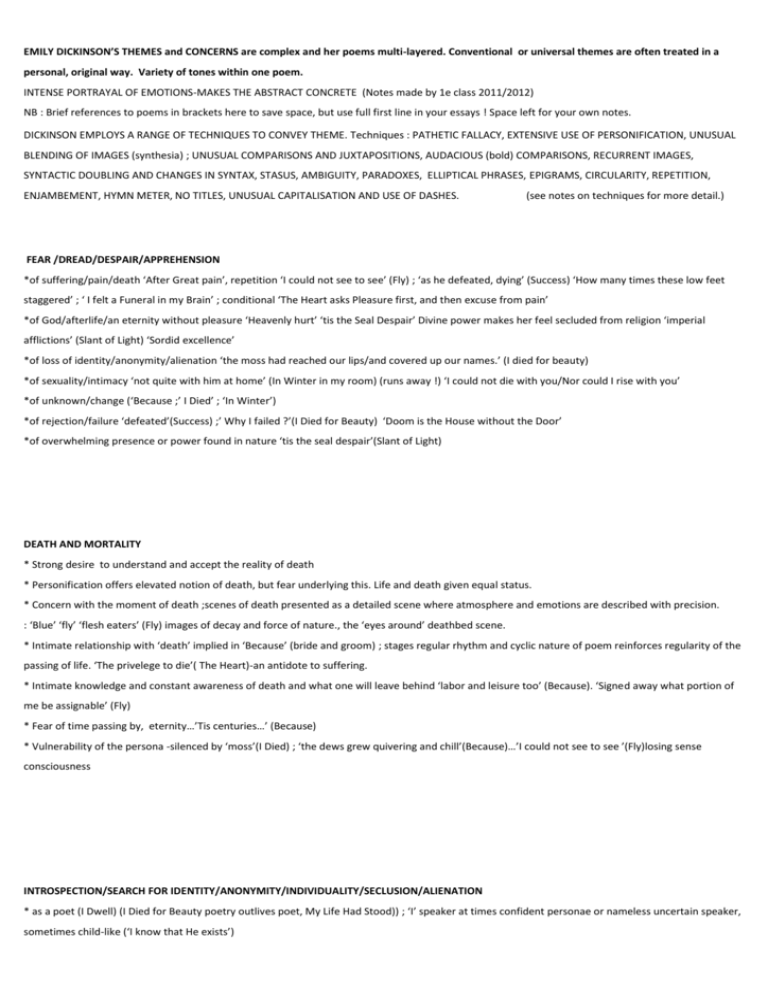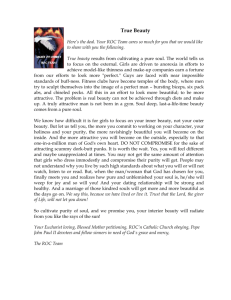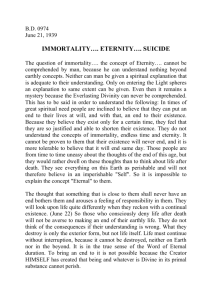File
advertisement

EMILY DICKINSON’S THEMES and CONCERNS are complex and her poems multi-layered. Conventional or universal themes are often treated in a personal, original way. Variety of tones within one poem. INTENSE PORTRAYAL OF EMOTIONS-MAKES THE ABSTRACT CONCRETE (Notes made by 1e class 2011/2012) NB : Brief references to poems in brackets here to save space, but use full first line in your essays ! Space left for your own notes. DICKINSON EMPLOYS A RANGE OF TECHNIQUES TO CONVEY THEME. Techniques : PATHETIC FALLACY, EXTENSIVE USE OF PERSONIFICATION, UNUSUAL BLENDING OF IMAGES (synthesia) ; UNUSUAL COMPARISONS AND JUXTAPOSITIONS, AUDACIOUS (bold) COMPARISONS, RECURRENT IMAGES, SYNTACTIC DOUBLING AND CHANGES IN SYNTAX, STASUS, AMBIGUITY, PARADOXES, ELLIPTICAL PHRASES, EPIGRAMS, CIRCULARITY, REPETITION, ENJAMBEMENT, HYMN METER, NO TITLES, UNUSUAL CAPITALISATION AND USE OF DASHES. (see notes on techniques for more detail.) FEAR /DREAD/DESPAIR/APPREHENSION *of suffering/pain/death ‘After Great pain’, repetition ‘I could not see to see’ (Fly) ; ‘as he defeated, dying’ (Success) ‘How many times these low feet staggered’ ; ‘ I felt a Funeral in my Brain’ ; conditional ‘The Heart asks Pleasure first, and then excuse from pain’ *of God/afterlife/an eternity without pleasure ‘Heavenly hurt’ ‘tis the Seal Despair’ Divine power makes her feel secluded from religion ‘imperial afflictions’ (Slant of Light) ‘Sordid excellence’ *of loss of identity/anonymity/alienation ‘the moss had reached our lips/and covered up our names.’ (I died for beauty) *of sexuality/intimacy ‘not quite with him at home’ (In Winter in my room) (runs away !) ‘I could not die with you/Nor could I rise with you’ *of unknown/change (‘Because ;’ I Died’ ; ‘In Winter’) *of rejection/failure ‘defeated’(Success) ;’ Why I failed ?’(I Died for Beauty) ‘Doom is the House without the Door’ *of overwhelming presence or power found in nature ‘tis the seal despair’(Slant of Light) DEATH AND MORTALITY * Strong desire to understand and accept the reality of death * Personification offers elevated notion of death, but fear underlying this. Life and death given equal status. * Concern with the moment of death ;scenes of death presented as a detailed scene where atmosphere and emotions are described with precision. : ‘Blue’ ‘fly’ ‘flesh eaters’ (Fly) images of decay and force of nature., the ‘eyes around’ deathbed scene. * Intimate relationship with ‘death’ implied in ‘Because’ (bride and groom) ; stages regular rhythm and cyclic nature of poem reinforces regularity of the passing of life. ‘The privelege to die’( The Heart)-an antidote to suffering. * Intimate knowledge and constant awareness of death and what one will leave behind ‘labor and leisure too’ (Because). ‘Signed away what portion of me be assignable’ (Fly) * Fear of time passing by, eternity…’Tis centuries…’ (Because) * Vulnerability of the persona -silenced by ‘moss’(I Died) ; ‘the dews grew quivering and chill’(Because)…’I could not see to see ’(Fly)losing sense consciousness INTROSPECTION/SEARCH FOR IDENTITY/ANONYMITY/INDIVIDUALITY/SECLUSION/ALIENATION * as a poet (I Dwell) (I Died for Beauty poetry outlives poet, My Life Had Stood)) ; ‘I’ speaker at times confident personae or nameless uncertain speaker, sometimes child-like (‘I know that He exists’) * as a woman/person. Proud of her identity in ‘I’m Nobody’ ; ‘The Soul’ ; ‘I Died’ Self assured in ‘My Life had Stood’. Bold, assertive or buoyant rhythm * as a wife ‘I’m wife-I’ve finished that’ or lover questioning the possibility of maintaining a relationship (I cannot live with you ; Because) * sense of separation, apartness from others, conscious withdrawal from society in ‘I heard a fly buzz, I’m nobody, The Soul Selects.’ * achievement of status (through experiences of love, death, marriage, poetic expression) and lack of status (imperial images and figures are at times rejected) * necessity of maintaining integrity, being selective in choices made (I’m Nobody’ ; ‘The Soul Selects’) * own space, often enclosed, to form own conceptions of religion, self, the afterlife. * Transcendental influence ‘know thyself’ (Emerson) POSSIBILITY/HOPE/TRUST *’the letting go’ ‘excuse from pain’ relief, release through death , numbness, sense of positivity and possibility * Anticipation, eagerness, pleasure in longing in ‘Wild Nights’ * Hope and trust in self, poetry, like-minded souls (Soul Selects), nature (Bird) Master (My Life) * Hope for another chance in ‘Success ‘. Despite failure, you can hold on to the hope of what you failed to achieve. * Moves from hope to hopelessness in ‘The Heart asks Pleasure first’ ; ‘In Winter’ PASSION/LOVE/LUST/ELATION/INTENSITY/DELIGHT *Poetry (over prose) ‘I dwell in Possibility’ and ‘They shut me up in Prose’ *Lust, sexual passion : Wild Night’s storms, winds, buoyant tone ; repetition and Spondaic metre ; ‘In Winter in my Room’metamorphosis of worm into snake ; ‘Started Early, took my Dog’ *Delight in ‘I taste a liquor never brewed’, ‘ A Bird came down the Walk’ *Intense emotion and ideals –martyrdom in ‘I Died for Beauty’ ; ‘agonised and clear, strains of triumph’ (Success) asserted ‘I Cannot Live with You’. *Assertive protection of lover ‘I’m Deadly foe’ ( My Life had Stood’) NATURE=’the heavens below’ *Associated with passion, delight, glory, possibility, joy ,beauty : ‘for an Everlasting Roof /the Gambrels of the Sky’ *Dangerous, powerful, overwhelming ; at times both admires and fears the potential danger (‘ringed with power’ in Winter, or oppressive nature ‘Slant of Light’, the ‘moss’ in ‘I Died for Beauty’. Associated with pain or death itself in many of her poems. *Personified-often elevated and described with precision and imagination : ‘butterflies off banks of noon’( A Bird) ; ‘frog’ in I’m Nobody’ represents human arrogance, ; ‘landscape listens’ *Man and nature interaction explored : A Bird, In Winter… *Incomprehensible *Divine images associate nature with eternity and spirituality : Garden of Eden a recurring image. *Seasons-winter summer, temperature , times of day, natural cycles of life and continuity in ‘the fields of gazing grain’(Because) the inevitable death as motifs and themes. *Pathetic fallacy. SEARCH FOR TRUTH/RELIGION/SPIRITUALITY/UNIVERSAL TRUTHS *"the depths in every consciousness from which we cannot rescue ourselves--to which none can go with us" (letter, 1878).-loneliness in search for truth * Concerned with portraying the inner life of the soul * Presenting an experience or emotion with intensity * Recurring allusions to paradise, Eden, Eternity, Immortality, ‘He’ blended with surprising or ambiguous images * Fear of God ; awe ; fear of religious oppression ‘Heavenly Hurt’, ritual. ‘Some keep the Sabbath going to church/ I keep it staying at home’. * Religious, biblical allusions throughout : ‘Cup’ (Icannot) metaphors : ‘its inquisita’ ; windows ; sunlight ; ‘Cathedral tunes’ (Slant of Light), HYMN METER * Recurring image of elite, royal figures (human or representing Divinity) ‘king’ ‘emperor’ ‘Divine majority’ ‘I died for Truth’ * NATURE is something divine, awe-inspiring. Transcendentailist influences. TIME * Sense of permanence : eternity, immortality (Because, I died ) * Timelessness. frozen moments (Slant of light ); After great pain ; time dimensions may become blurred of confused (Because) * Travel through time : past to future, mortality to immortality * Passage of time causing change * Attempts to recapture past or precious moments (A Bird) or imagine brighter future * Used as a structural device in her storytelling. Consider also : SOCIAL CONCERNS : CLASS CONCERNS/FEMINIST ISSUES







